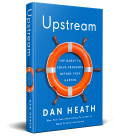Nicholas Kristof has a sticky piece today on the grotesque overpayment of CEOs who fail. Case in point: Richard Fuld, chief of the now-flushed Lehman Brothers, made a half-bil between 1993 and 2007. Good investment.
This story, and others like it, run the board on the traits of a sticky idea: They’re simple (Too much money!). Unexpected ($17,000 an hour!). Concrete ($6,000 shower curtains). Credible (the amounts are indisputable). Emotional (Outrage, envy, disgust). Story (Pick your CEO). And yet the public outcry never builds up to a roar. Only a half-hearted squawk.
I can’t explain it. Maybe people feel powerless to affect it. I.e., if you were really angry, to your core, about CEO pay, what would you do next? At least with global warming, you can switch out a lightbulb. But sadly, there’s no incremental action with CEOs — you can’t take a dollar out of Fuld’s pocket. (Even if you did, it wouldn’t be worth his time to retrieve it, because in the next 10 seconds, he’d have made another $47.)



